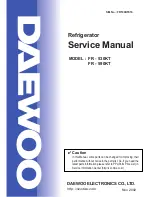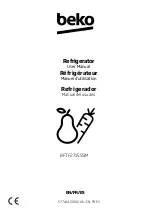
4
Food must be frozen as rapidly as possible
when they are put in a refrigerator in order to
keep them in good quality.
The TSE norm requires (according to certain
measurement conditions) the refrigerator to
freeze 4.5 kg of foodstuff at 32°C ambient
temperature to -18°C or lower within 24 hours
for every 100-liters of freezer volume.
It is possible to keep the food for a long
time only at -18°C or lower temperatures.
You can keep the freshness of food for
m a n y m o n t h s ( a t - 1 8 ° C o r l o w e r
temperatures in the deep freeze).
WARNING!
• The foodstuff that you want to freeze
must be in good quality.
• Foodstuff must be divided into portions
according to the family's daily or meal based
consumption needs.
• Foodstuff must be
packaged
in an
airtight manner to prevent them from drying
even if they are going to be kept for a short
time.
Deep-Freeze information
1.
Do not keep the doors of your refrigerator
open for a long time.
2
. Do not put hot food or drinks in your
refrigerator.
3
. Do not overload your refrigerator so that
the air circulation inside of it is not prevented.
Things to be done for saving energy
25
4
. Do not install your refrigerator under direct
sunlight or near heat emitting appliances such
as oven, dishwasher or radiator.
5
. Pay attention to keep your food in closed
containers.
Materials necessary for packaging:
• Cold resistant adhesive tape
• Self adhesive label
• Rubber rings
• Pen
Materials to be used for packaging the
foodstuff must be tear-proof and resistant to
cold, humidity, odor, oils and acids.
Foodstuff to be frozen should not be allowed
to come in contact with the previously frozen
items to prevent their partial thawing.
You can check the freezing capacity of your
refrigerator from
“Technical Specifications”
section in Part 1.
Always follow the values in the tables for
storage periods.
Frozen food must be used immediately
after they are thawed and they should
never be re-frozen.
EN








































